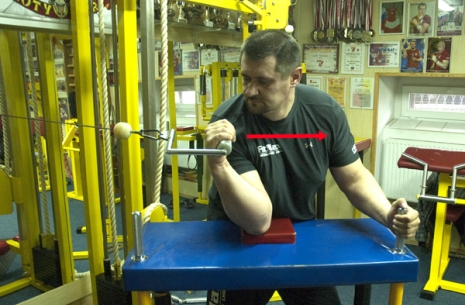
Armwrestling demands from its beginners to follow certain rules and regulations. Here are some of them. ()
An armwrestling beginner is bound to experience a certain amount of pain, as a result of engaging hitherto unused muscles. However, systematic training will train muscles to take the strain, and the pain will eventually subside. That will mean that one is training well and up to one’s individual specifications, physical and psychological. At this stage the role of the coach is crucial, it’s he that is responsible for guiding a beginner on their road to armwrestling prowess.
One of the most important rules for the beginners is not to wrestle at the table. Attempting this without previous preparations of the ligament – muscle system can result in what is called DOMS – delayed onset muscle soreness, and leads to injury.
In armwrestling practice, we can separate several types of movement:
Dynamic
Excentric
Isometric
Plyometric
The last types have a crucial influence in reaching the champion level of armwrestling.
Young adepts who wish to begin training should concentrate on strengthening their fingers, wrists and biceps (exercises with undergrip and hammer grip). Focus on static strength, forgo dynamic movement for the time being. The optimum number of workouts per week is 4, with the minimum of 3 and a maximum of 5.
An experienced coach should start with interviewing a prospective trainee; this will help to establish the trainee’s level of previous sports experience, especially in armwrestling.
After conducting this interview, an ideal first test of predispositions is performing pullups, at this point the grip doesn’t matter. If the number of pullups performed is less than 6, through general training our potential champion should progress to 10 – 12 pullups per set.
To keep exact track of our protégé’s progress, we should keep a training journal. It’s an ideal tool to helps us observe the aforesaid progress. The ideal progress rate is some 50 – 60 % increase in 3 months from the beginning. If that rate is lower, the candidate needs individual work and individual program, with exercises, sets and reps tailored to their needs.
In the beginning phase we can incorporate some individual table training. This will include only technical elements and will be an exercise in getting familiar with the table and fighting stance. After this phase is over, we can then proceed to teaching the whole movement range – a simulation of a fight, if you will, but without counter-pressure.
After some 3 months at the table, we can introduce sparring. Focus on the dynamics – concentric or isometric exercises only. It is very important for the young adept to perform fluid movements, so their partner must allow enough slack for them to “win” every such “fight”. There should be no fighting in defense at this point.
Begin the training with two preparatory sets, 15 – 20 reps. Next go on to 8 reps and descend gradually to 2 reps. Recommendable at this stage is supplementation with creatine, BCAA, glutamine and carbohydrates. Those supplements will shorten regeneration time and increase our student’s training potential.
Fresh fighters are always eager to train every day. The role of the coach here is to make them realize that progress is directly proportional to the rest phase between trainings.
After some 3 – 4 months we modify the training routine with about 40% of specialized exercises. This is also the right time for our trainee to determine his fighting technique. Genetic makeup plays a large role at this stage – a long arm and fingers will be ideal for fighting over the top, for example.
After some six months comes the perfect time to introduce some plyometric exercises. One can also begin the training with warm-up at the table. With time, the table trainings will become more and more frequent, because they play the biggest role in becoming a champion.
It can happen that after 7 months we still haven’t reached our training goals. This would be the time to interview our protégé about their eating habits. It may turn out that the slow progress is due to poor nutrition.
How to train a beginner? More on that in part 2, to be continued.



Archive >>>
DOPING SANCTIONS AT THE 2013 CHAMPIONSHIP
Last week's most popular articles
Evgenyi Prudnyk: „Kiss me Kate!”
TRAIN WITH IGOR MAZURENKO: WEAK WRIST THE CAUSE OF MANY FAILURES